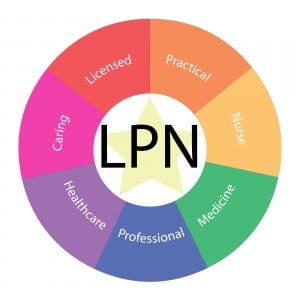Working as a Licensed Practical Nurse (LPN)
What Does LPN Stand For?
Licensed Practical Nurse (LPNs), also recognized in certain states as Licensed Vocational Nurses (LVNs – CA & TX).
What Do LPNs Do
The responsibilities of the LPN are contingent upon the laws governing the “scope of practice” in the state of employment. Each state’s nursing board establishes the parameters of what an LPN can or cannot undertake. Broadly speaking, LPNs offer patient care across diverse settings and clinical specializations. LPNs usually:

Struggling to meet your deadline?
Get your assignment on Working as a Licensed Practical Nurse (LPN) done by certified MDs and PhDs in the USA. ORDER NOW!
1. Take the patient’s vital signs
2. Change wound dressings
3. Collect specimens such as blood, urine, sputum, etc
4. Insert and care for urinary catheters
5. Care for patients with tracheostomy tube and ventilators
6. Insert and care for patients that need nasogastric tubes
7. Give feedings through a nasogastric or gastrostomy tube
8. Care for ostomies
9. Administer oral and intravenous medications
10. Chart in the medical record
11. Monitor patients for a change in clinical condition
12. Call the physician if needed
13. Perform CPR in emergencies
14. Are supervised by an RN
The Fastest Psychiatric-Mental Health Nurse Practitioner (PMHNP) Programs in 2024
Although each state defines the scope of practice for LPNs, individual organizations may further narrow this scope. It is crucial, therefore, to be aware of tasks that the specific organization does not permit LPNs to perform. In certain organizations, but not universally, RNs are expected to carry out the following responsibilities:
– Initiate, monitor, and/or discontinue intravenous catheters or intravenous fluids
– Initiate, monitor, or change critical intravenous medications stabilizing the heart or blood pressure
– Receive phone or verbal orders from the MD
– Administer intravenous medications given “push” or rapidly
– Attend to central intravenous lines (proximal to or within the patient’s heart)

What are LPN Duties?
LPN duties frequently vary based on the state of employment. Some state regulations authorize LPNs to dispense medication to patients, while others allow LPNs to administer intravenous drips.
In general, LPNs are tasked with aiding registered nurses and doctors by delivering fundamental medical care to patients. Common job duties undertaken by LPNs encompass:
– Changing bandages, catheters, and IVs
– Monitoring vital signs such as blood pressure and pulse rates
– Feeding patients who are incapable of self-feeding
– Maintaining detailed records of patients’ overall health
– Reporting any alterations in patients’ health to doctors and nurses
These represent only a fraction of the standard duties carried out by LPNs, and their day-to-day routines may fluctuate based on the requirements of hospitals, physician’s offices, or nursing homes where they are employed.
Additional duties LPNs may perform include:
Greeting Patients and Recording Their Information
LPNs frequently serve as the initial point of contact for hospitals, doctor’s offices, or other healthcare clinics with patients. After patients proceed for doctor consultations, LPNs document their medical history, known allergies, height, weight, internal body temperature, blood pressure, pulse, and breathing rate. These indicators provide doctors and registered nurses with an initial insight into patients’ overall health before any additional tests are conducted.
Collecting Samples
A pivotal day-to-day responsibility for LPNs is collecting patient samples for routine laboratory testing, such as urine, feces, saliva, and other bodily fluids. Additionally, some LPNs receive training to draw blood for testing certain diseases and infections.
Monitoring Patients’ Health
Given the demands on registered nurses and doctors who may need to attend to numerous patients in a single day, LPNs are tasked with monitoring their patients’ health throughout their shifts. Vigilant monitoring becomes especially critical after significant surgeries, accidents, or when patients receive new medications. LPNs possess the training to swiftly identify adverse reactions or complications and promptly notify doctors and registered nurses.
Counseling Patients and their Families
LPNs frequently assume the responsibility of imparting a compassionate touch to routine healthcare. They often educate patients and their family members on medication administration, symptoms to watch for after discharge, activities to avoid, and fostering and maintaining a healthy lifestyle. Gain more insights into the roles of LPNs.

Where Do LPNs Work?
The U.S. Bureau of Labor Statistics approximates that LPNs held employment in around 719,900 positions in 2015. These nurses were engaged in diverse settings, including:
- Nursing homes and nursing care facilities
- Home health care organizations
- Universities
- Physicians’ offices and other private practices
- State, federal, and private hospitals
- Elementary schools, middle schools, and high schools
Moreover, LPNs can explore opportunities in alternative settings by serving as missionaries, participating in the military, or working as consultants for healthcare companies. Some nurses leverage their knowledge of patient care and familiarity with healthcare environments by pursuing careers as medical coders, billers, transcriptionists, and customer service representatives. Evaluate the myriad potential practical nursing careers.
LPN Work Environments
The primary locations where an LPN is employed encompass, but are not restricted to:
- Hospital – This setting delivers care to patients dealing with acute illness or those who have recently undergone major surgery. The LPN collaborates with RNs under supervision in patient care. While most community hospitals hire LPNs, larger teaching hospitals striving for “magnet status” from The Joint Commission (the hospital accreditation organization) typically refrain from LPN recruitment. Work schedules vary by facility but typically involve 12-hour shifts with alternating weekends off and rotating shifts.
- Rehabilitation – In this setting, care is provided to patients on the path to recovering skills after a recent medical or surgical event. Patients are expected to show improvement with the assistance of physical, occupational, and speech therapists. LPNs and RNs work in tandem to care for patients. For instance, a patient may have undergone hip replacement surgery in the hospital but still needs to regain muscle strength, crutch walking skills, and practice ambulating on different surfaces. Such patients can transition to a rehabilitation setting to achieve these goals. Work schedules, as in other settings, typically involve 12-hour shifts with alternating weekends off and rotating shifts.
- Nursing Home – This setting caters to patients with long-term care needs, where improvement may not be anticipated, and the stay may extend for extended periods. The LPN might take charge of patient care in this scenario. For example, a stroke patient might initially be hospitalized post-stroke, then move to a rehabilitation center to work on speech and movement skills. Once the patient’s progress plateaus, and if home care support is insufficient, long-term care in a nursing home becomes an option. Work schedules vary, often involving 12-hour shifts with alternating weekends off and rotating shifts, although some long-term care facilities may opt for 8-hour shifts.
- Home Care – Many patients can receive care in their homes or a family member’s residence with additional healthcare support. The type of home care provided depends on the patient’s needs. Some complex cases require several hours of LPN care daily to allow family members to rest, while others may need LPN oversight to ensure the continuity of the medical plan at home and provide patient education. The shift hours depend on the required hours per day or week, with episodic visits lasting from 1 to 2 hours.
- Medical Office or Urgent Care Clinic – This setting facilitates office visits for patients to consult their healthcare providers, typically for routine checkups. The LPN can contribute by recording vital signs, medication history, weight, and facilitating necessary follow-up tests after the visit. LPN hours are contingent on the office’s operating times, with occasional weekends included.
- School – Students in educational institutions might require episodic care for minor illnesses such as lice, sore throats, or vomiting. RNs or LPNs may be hired by elementary schools, high schools, and colleges to provide such care. For younger students, parents usually pick them up, while college students receive care until deemed safe to commute unless emergency hospital care is necessary. Work hours align with the school’s operational hours and student presence.
The Fastest Master of Science in Nursing (MSN) Programs in 2024
LPN Areas of Expertise
There exist several captivating domains within nursing practice from which LPNs can choose to specialize. Each area holds its uniqueness, just as each LPN does. It is advisable to explore various nursing areas over time to enhance your professional appeal. Discover more about the 8 roles of LPNs and the diverse LPN career opportunities.
- Pediatrics – This nursing care specialization focuses on treating sick patients ranging from newborns to 18 years old.
- Labor and Delivery – Nurses in this specialization cater to pregnant women before, during, and after delivery, along with caring for well newborns.
- Neonatal – Nurses in neonatal units attend to sick newborns and premature infants post-delivery.
- Oncology – Patients in need of oncology nursing typically have various forms of cancer. Oncology nurses administer chemotherapy, manage pain and nausea, and assist in procedures.
- Neuro ICU – Nurses in the Neuro ICU care for patients post-brain surgery or severe head injuries. They specialize in neurological patient assessment and monitoring for improvement or deterioration.
- Trauma ICU – Trauma ICU nurses provide care for patients after accidents involving multiple systems, such as car accidents, motorcycle accidents, or building collapses.
- Burn Unit – Nurses in the Burn Unit specialize in dressing changes, pain management, and monitoring for sepsis in patients with extensive burns, collaborating within a team throughout the patient’s healing process.
- Cardiac ICU – Patients receive nursing care in a Cardiac ICU post-heart surgery.
- Emergency Room – Emergency room nurses attend to suddenly unstable patients after an illness or accident, stabilizing them quickly before transferring to an ICU.
- Rehabilitation Nurse – Rehabilitation nursing involves collaboration with physical, occupational, and speech therapists to help patients regain skills lost due to- illness or injury.
- Gerontology Nurse – Nurses specializing in gerontology address the unique needs of elderly patients.
Explore available BSN careers as you continue advancing your nursing education. Identify practical nursing opportunities now!
Finding Your LPN Job
Once you’ve determined your preferred area of practice, research locations where employers offer that specific care. For example, if you aspire to work in a Burn Unit, you might need to check various hospitals in the area to identify one with a dedicated Burn Unit, usually found in hospitals designated as Level 3 Trauma Centers. Visit the hospital’s website and navigate to their “Careers at Our Hospital” section. Search for jobs, specifically focusing on your desired area of practice. Review the job titles, position descriptions, work hours, shifts, and salary information. Compare job offerings across different facilities and narrow down your choices to two preferred job opportunities. Gain insights into the core values of nursing professionals. If you are interested in finding a position, explore available LPN jobs.
Completing an LPN Job Application
While many job applications are now submitted online, some may still be in hard copy format. Before initiating the application process, gather essential documents:
1. Employment History – Gather details about previous employment, including facility names, addresses, phone numbers, and supervisor information.
2. Education History – Collect information about your high school and nursing school, including names, addresses, and phone numbers. Consider obtaining an unofficial transcript from your LPN school, although it may not be frequently requested.
3. License Information – Ensure you know the date you took your LPN exam and in which state. While some employers may conduct online checks, it’s advisable to have a copy of your license. If considering working in another state, learn how to transfer your LPN license accordingly.
4. Follow Instructions – Pay careful attention to completing the application accurately, using correct spelling and proper grammar. Fill in all sections to the best of your ability. Non-compliance with instructions can reflect on how you might handle instructions on the job, so strive to make a positive impression!
5. Test Preparation – Be aware that some hospitals may require a math test before hiring an LPN. Prepare for topics like simple ratios, IV drip conversions, medication names, and purposes. Inquire about the pass/fail cutoff. Take your time, especially if it’s not a timed test. The test might be part of the online application or administered during an interview.
6. Submission – Before finalizing the paper application or clicking the “submit” button online, thoroughly review all information to ensure completeness. Some employers may reject incomplete applications.
LPN Job Interview
If you’ve received an invitation for a job interview, there are several crucial considerations to keep in mind. Firstly, conduct thorough online research about the organization to which you are applying. Understand their specialized care areas, the specific care settings they operate in, and the annual patient load they handle. Familiarize yourself with the responsibilities and limitations of the job you are pursuing within the organization. Dress appropriately for the position and bring a printed copy of your resume. Engage in practice sessions for potential interview questions and answers with a friend. Online resources, such as interview preparation videos, can be valuable aids in getting ready.
Explore more insights in our comprehensive LPN Interview Guide. For detailed information on specific topics, refer to the sections below:
1. Dress for Success
2. Interview Timing
3. Do Your Homework
4. Expect the Unexpected
5. 10 Common Interview Questions & Answers
6. Practice Makes Perfect
7. Say “Thank You”
Commencing Work as an LPN
Upon accepting a job offer and agreeing on the salary, the subsequent step involves receiving a start date for your employment. In some cases, a pre-employment physical examination, including drug testing, may be required. Prepare by procuring necessary items such as nursing scrub outfits or a stethoscope. You will be provided with a computer security username and password, granting access to timekeeping, medical records, and registration systems. Completion of various educational requirements specific to your role and department is typically necessary within the initial days of joining an organization.
LPN Work Orientation Period
The initial month or so in a new organization constitutes your orientation period. This phase serves the dual purpose of allowing the organization to assess your skills for the job and providing you with the opportunity to determine if the job aligns with your expectations. Depending on your role and the setting, the orientation period may extend up to 6 weeks. A preceptor or mentor will be assigned to guide you through orientation and assess your competency. At the conclusion of this period, an evaluation process usually takes place to gather performance feedback from your supervisor.
LPN License Renewal
After obtaining your LPN state license for the first time, it is essential to keep track of the expiration date. Pay close attention to your state’s licensure renewal requirements, as these can vary. Some states may only require a fee for renewal, while others might mandate additional continuing education credits (with varying hour requirements) as a prerequisite for renewal. Be vigilant about meeting your state’s specific requirements and timelines.
LPN Continuing Education Credits
Certain State Boards of Nursing mandate a specific number of continuing education credits for LPN license renewal. Continuing education credits encompass accredited videos, articles, lectures, or conferences that enhance the LPN’s knowledge to ensure ongoing competency. The policies regarding these credits vary by state, so it is advisable to consult our guide on LPN CEU state requirements or visit a third-party resource for a comprehensive list of all states and their continuing education requirements. Explore additional avenues for acquiring CEUs for LPNs.

Dont wait until the last minute.
Provide your requirements and let our native nursing writers deliver your assignments ASAP.

